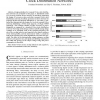Free Online Productivity Tools
i2Speak
i2Symbol
i2OCR
iTex2Img
iWeb2Print
iWeb2Shot
i2Type
iPdf2Split
iPdf2Merge
i2Bopomofo
i2Arabic
i2Style
i2Image
i2PDF
iLatex2Rtf
Sci2ools
ISCAS
2006
IEEE
2006
IEEE
Design methodology for global resonant H-tree clock distribution networks
Abstract—Design guidelines for resonant H-tree clock distribution networks are presented in this paper. A distributed model of a two-level resonant H-tree structure is described, supporting the design of low power, skew, and jitter resonant H-tree clock distribution networks. Excellent agreement is shown between the proposed model and SpectraS simulations. A case study is presented that demonstrates the design of a two-level resonant H-tree network, distributing a 5-GHz clock signal in a 0.18- m CMOS technology. This example exhibits an 84% decrease in power dissipation as compared to a standard H-tree clock distribution network. The design methodology enables tradeoffs among design variables to be examined, such as the operating frequency, the size of the on-chip inductors and capacitors, the output resistance of the driving buffer, and the interconnect width. A sensitivity analysis of resonant H-tree clock distribution networks is also provided. The effect of the driving buffer out...
Related Content
| Added | 12 Jun 2010 |
| Updated | 12 Jun 2010 |
| Type | Conference |
| Year | 2006 |
| Where | ISCAS |
| Authors | Jonathan Rosenfeld, Eby G. Friedman |
Comments (0)

